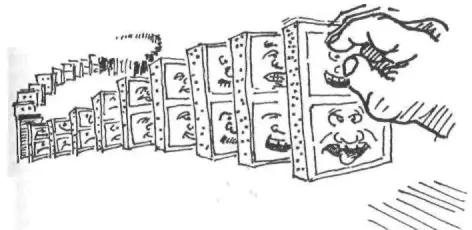Richard Bandler - Using Your Brain —for a CHANGE
- Название:Using Your Brain —for a CHANGE
- Автор:
- Жанр:
- Издательство:Real People Press
- Год:1985
- Город:Moab, Utah
- ISBN:0–911226–26–5
- Рейтинг:
- Избранное:Добавить в избранное
-
Отзывы:
-
Ваша оценка:
Richard Bandler - Using Your Brain —for a CHANGE краткое содержание
Bandler is an innovator and an original thinker in the field of psychology. This book is a transcript of Bandler live in front of an audience, cutting up and cracking jokes as he is prone to do, talking about some of his unique and often practical views on how you can change your feelings, thoughts and behavior. Change is often easier than you think if you use the right method.
Using Your Brain —for a CHANGE - читать онлайн бесплатно полную версию (весь текст целиком)
Интервал:
Закладка:
B. Belief Change Process
6. Belief to Doubt: Keeping the content the same, change the unwanted belief to doubt by using one or more of the most powerful submodalities you discovered in step 4. For instance, if the two most powerful differences were movie to slide, and close panorama to distant framed picture, have the panoramic movie slow to a still slide as it moves away and becomes a framed picture.
7. Change Content: Using some other submodality, change the content from the old unwanted belief to the new desired belief. Use something she already does, or any gradual analogue method. For example, if she flips pictures back and forth in doubt, she can flip from the old content to the new content. You could have the old belief picture go off into the distance so far that it's impossible to tell what it is, then have it come back with the new belief image. You can have the picture get so bright or so dim that the old content disappears, and then have it come back with the new content, etc.
8. Doubt to Belief: Keeping the new content, change doubt to belief by reversing the same submodality changes you used in Step 6. If shifting location to the right changed the old belief to doubt, you now shift location back to the left to change the new content from doubt to belief. As you do this, be very alert for any "resistance," or difficulty that your partner has. If the new belief is stated poorly, or has any negations in it, some part of the person may object to it. When you encounter objections, honor them, gather information, and back up to step 5 to redefine the new belief.
C. Testing
9. There are several ways to test. You can ask "How do you think about this new belief?" Ask for information about submodalites, and use nonverbal behavior to confirm (or disconfirm) the verbal report.
10. When the new belief is in place, the old belief will probably change to the submodalities of disbelief. If you find out how the old belief is represented now, you can compare that with the submodalities of doubt, which you already know, or with the submodalities of disbelief, which you can find out by asking the person to think of something else she firmly disbelieves.
I've often said that good NLP work is 95% information–gathering and 5% intervention. The first five steps are setting things up for the intervention. That makes it easy to make the actual intervention smooth and fast. Remember, brains learn quickly; they don't learn slowly. If you get it all set up ahead of time, it's a lot easier to do a good job. It's a little like setting up a whole string of dominoes, and then tapping the first one.
Go ahead and try this pattern now, in groups of three. I know some of you have questions; many of those questions will be answered by the exercise itself. The questions you still have later will be a lot more interesting after you have had some experience of actually trying out this pattern. My answers will make a lot more sense to you, too.

Now that you've had some experience trying this, let's take some questions and comments.
Man: When I made the belief change, I had a lot of profound internal sensations. It felt as if there were a lot of little fish swimming around in my brain and my body, and the two people observing saw a lot of visible shifts, too. Is this typical?
When the belief is a major one, that's a typical report. Core beliefs organize a lot of a person's behavior. When you make a change in a core belief, you often get a profound internal reorganization. If it's a more peripheral belief, the changes aren't as striking.
Man: I found it hard to think of a useful belief to change. I'd like to hear some content examples of what people changed. Woman: I've been struggling and struggling for years to lose the last five pounds to get to the weight I want to be. It's easy for me to get close to the weight I want to be, but I've always believed I had to struggle and fight to control myself in order to lose that last five pounds. So I changed my belief that it was hard, to the belief that it will be easy to lose those last five pounds. What a relief; I feel so much more relaxed,
Man: I worked with her on that, and it was really nice to watch her go through the change. Her face, her voice, her whole body — everything was a lot more relaxed afterwards.
Woman: I've had a runny nose and I changed the belief that I couldn't do anything about it. I was amazed, because I can actually feel my nose beginning to dry up.
Man: I started with the belief that it was dangerous for me to drive at night without my glasses. I wanted to change it to the belief that I could safely drive without my glasses at night. Then my partner pointed out that my desired belief was a goal, and that it might be dangerous to change to that belief, I might go driving at night thinking I was safe when I wasn't. So we changed to the belief that I can learn to drive safely at night without glasses. I think I was really working on a much more general belief that I couldn't learn, period. I have a sense that this will affect much more than just driving at night; it seems much broader than that.
Great. Changing the belief that you can't learn something is useful for a lot of people. Many people try something once, don't succeed at it, and conclude they can't do it and they can't learn to do it. I know a man who "knew" he couldn't play the piano: "I sat down at the piano and tried it once, but nothing came of it." I start off with the belief that as long as you have most of your brain cells intact, anyone can do anything. You may need to chunk down the task, or learn to do it differently, and it may take you a while to get good at it, but starting with the belief that you can learn will take you a long way. My belief may even be wrong sometimes, but it makes it possible for me to do things and get results that I would never even consider if I assumed people were genetically incapable.
Man: Several people are using firewalking as a way to change people's limiting beliefs. Can you comment on that?
If someone believes they can't do something like firewalking and you get them to discover that it's possible, that can certainly shatter an old belief, particularly if they're told, "If you can walk on fire, you can do anything!" However, there's no way to carefully specify the new belief that gets put in its place. I read about one person who went through a firewalk and said, "Now I believe that I could be standing right at the explosion of a nuclear warhead, and it wouldn't affect me." If he's lucky, he won't ever get to test that belief, but it's an example of the kind of junky beliefs that can get installed that way. If you install beliefs that way, people often put in beliefs that don't relate to evidence or feedback. One firewalk teacher is calling himself "the foremost NLP trainer," when he hasn't even been certified as a master practitioner, much less a trainer! Some of his other beliefs have even less evidence for them.
I know that some people have gotten some very useful belief changes from doing the firewalk. Even a stopped clock is right twice a day. The problem with firewalking is that you have little control over the new belief that takes the place of the old one. There are enough bizarre and dangerous beliefs in the world without adding to them with a random process.
Another problem with something like firewalking is that it tends to install the belief that it takes a really dramatic external event to get you to change. I'd rather install the belief that change happens constantly, and easily, and making it work for you is a matter of understanding how to run your own brain. It doesn't take walking on hot coals to do that.
There is a completely separate issue of whether firewalking is actually something that's difficult to do or not, and whether the six hours of evangelistic preparation makes any difference in being able to walk on the coals. A reporter from the Rolling Stone timed people as they walked across and found a range of 1.5 seconds to 1.9 seconds, with an average of about 1.7 seconds. The length of the walk was about 10 feet, so if you have a 30" stride you can easily make it across in 4 steps — two on each foot. That gives a maximum of less than half a second of actual contact per footstep. Firewalkers make a big deal about the temperature of the coals—1,400 to 2,000 degrees — but they don't mention that each foot has only two contacts with the coals lasting less than half a second each. When you pick up a hot coal that's landed on your carpet to throw it back into the fireplace, your fingers probably contact the coal for about that long— and your fingertips are much more sensitive than your feet.
Burning requires heat transfer, not just temperature, and the contact time is only one factor in heat transfer. Another factor is conductivity. Let's say you're in a cabin in the mountains and you get out of bed in the morning when it's 20 degrees below zero, and one bare foot lands on a steel plate, while the other lands on a sheepskin rug. Even though the rug and the steel are both at 20 degrees below, the steel will feel a lot colder than the rug, because of it's greater heat conductivity. The conductivity of charcoal is greater than sheepskin, but a lot less than steel. Ask the next firewalker you meet if he's willing to walk the same length on a steel plate that's at the same temperature as those coals!
There is an additional factor that physicists call the "Leiden–frost effect." When there is a significant temperature difference between two substances, and the cooler one is a liquid or contains liquid, a thin vapor layer forms to create an insulating barrier that reduces heat transfer significantly.
All the evidence I have indicates that a ten foot, 1.5 second firewalk is something' anyone can do, with or without evangelistic preparation, but very few people think they can do.
Woman: Some people have beliefs that don't seem to influence their behavior much. For instance, I have a boss who always talks about how people should be nice to each other, but he's usually mean to people himself. How do you explain that?
I try to understand how things work, not "explain" them. There are several possibilities. One is that this belief is not really something he believes, even though he talks about it. A lot of "intellectuals" have beliefs like that which have no effect on their behavior. In that case you could use the belief change pattern to make his belief into one that is subjectively real enough to affect his behavior.
Another possibility is that his belief is real enough, but it's selective: other people should be nice to him, but he doesn't need to be nice to them, because he's special. Kings, dictators, and some movie stars are like that. Beliefs aren't always reciprocal.
A third possibility is that your boss' belief is real, and reciprocal, but what he thinks of as "being nice" seems "mean" to you. In the 60's a lot of humanistic psychologists would hug everyone too hard because they believed it was a nice thing to do, without noticing whether the "huggee" liked it or not. They'd also go around insulting people, because they thought it was always good to be honest and tell the truth. The crusaders believed that saving souls was an important thing to do, and they didn't care if it was sometimes necessary to kill the body in order to do it.
Читать дальшеИнтервал:
Закладка:








